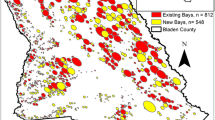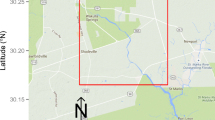Abstract
Comprehensive wetland inventories are an essential tool for wetland management, but develo** and maintaining an inventory is expensive and technically challenging. Funding for these efforts has also been problematic. Here we describe a large-area application of a semi-automated process used to update a wetland inventory for east-central Minnesota. The original inventory for this area was the product of a labor-intensive, manual photo-interpretation process. The present application incorporated high resolution, multi-spectral imagery from multiple seasons; high resolution elevation data derived from lidar; satellite radar imagery; and other GIS data. Map production combined image segmentation and random forest classification along with aerial photo-interpretation. More than 1000 validation data points were acquired using both independent photo-interpretation as well as field reconnaissance. Overall accuracy for wetland identification was 90 % compared to field data and 93 % compared to photo-interpretation data. Overall accuracy for wetland type was 72 and 78 % compared to field and photo-interpretation data, respectively. By automating the most time consuming part of the image interpretations, initial delineation of boundaries and identification of broad wetland classes, we were able to allow the image interpreters to focus their efforts on the more difficult components, such as the assignment of detailed wetland classes and modifiers.




Similar content being viewed by others
References
Alaska Satellite Facility (2011) MapReady Remote Sensing Tool Kit Version 2.3.17 [computer software]. Available from https://www.asf.alaska.edu/data-tools/mapready/
Austin JE, Buhl TK, Guntenspergen GR, Norling W, Sklebar HT (2001) Duck populations as indicators of landscape condition in the prairie pothole region. Environmental Monitoring and Assessment 69(1):29–48
Baatz M, Schäpe A (2000) Multiresolution segmentation: an optimization approach for high quality multi-scale image segmentation. In: Strobl J, Blaschke T (eds) Angewandte geographische informationsverarbeitung XII. Wichmann, Heidelberg, pp 12–23
Ball Aerospace & Technologies Corp (2011) Opticks Version 4.7.1. Available from http://opticks.org
Beven KJ, Kirkby MJ (1979) A physically based, variable contributing area model of basin hydrology. Hydrological Sciences Journal 24(1):43–69
Bourgeau-Chavez LL, Kowalski KP, Carlson Mazur ML, Scarbrough KA, Powell RB, Brooks CN, Huberty B, Jenkins LK, Banda EC, Galbraith DM, Laubach ZM, Riordan K (2013) Map** invasive phragmites Australis in the coastal great lakes with ALOS PALSAR satellite imagery for decision support. Journal of Great Lakes Research 39(1):65–77
Breiman L (2001) Random forests. Machine Learning 45(1):5–32
Brisco B, Touzi R, Van der Sanden J, Charbonneau F, Pultz T, D’Iorio M (2008) Water resource applications with Radarsat-2. International Journal of Digital Earth 1(1):130–147
Burkett V, Kusler J (2000) Climate change: potential impacts and interactions in wetlands of the United States. Journal of the American Water Resources Association 36(2):313–320
Congalton RG, Green K (2008) Assessing the accuracy of remotely sensed data: principles and practices. CRC press
Corcoran JM, Knight JF, Brisco B, Kaya S, Cull A, Murhnaghan K (2011) The integration of optical, topographic, and radar data for wetland map** in northern Minnesota. Canadian Journal of Remote Sensing 27(5):564–582
Corcoran JM, Knight JF, Gallant AL (2013) Influence of multi-source and multi-temporal remotely sensed and ancillary data on the accuracy of random forest classification of wetlands in Northern Minnesota. Remote Sensing 5(7):3212–3238
Costa LT, Farinha JC, Vives PT, Hecker N, Silva EP (2001) Regional wetland inventory approaches: The Mediterranean example. In Wetland Inventory, Assessment and Monitoring: Practical Techniques and Identification of Major Issues. Finlayson CM, Davidson NC & Stevenson NJ (eds). Proceedings of Workshop 4, 2nd International Conference on Wetlands and Development, Dakar, Senegal, 8–14 November 1998, Supervising Scientist Report 161, Supervising Scientist, Darwin
Cowardin LM, Carter V, Golet FC, LaRoe ET (1979) Classification of wetlands and deepwater habitats of the United States. U.S. Fish and Wildlife Service Report No. FWS/OBS/-79/31, Washington
Dahl TE, Dick J, Swords J, Wilen BO (2009) Data collection requirements and procedures for map** wetland, deepwater and related habitats of the United States. Division of habitat and resource conservation, national standards and support team. U.S. Fish and Wildlife Service, Madison, p 85
Definiens AG (2009) Definiens eCognition developer 8 user guide. Definens AG, Munchen
Dost RJJ, Mannaerts CMM (2008) Generation of lake bathymetry using sonar, satellite imagery and GIS. In ESRI 2008: Proceedings of the 2008 ESRI International User Conference
Drazkowski B, May M, Herrera DT (2004) Comparison of 1983 and 1997 southern Michigan national wetland inventory data. Department of Environmental Quality, Geological and Land Management Division, Michigan, p 15
ERDAS (2008) ERDAS imagine version 9.2 [computer software]. Intergraph Corporation, Norcross
ERDAS (2010) StereoAnalyst for ArcGIS version 10.0 [computer software]. Intergraph Corporation, Norcross
ESRI (2011) ArcGIS desktop: release 10 [computer software]. Environmental Systems Research Institute, Redlands
Euliss NH Jr, Gleason RA, Olness A, McDougal RL, Murkin HR, Robarts RD, Bourbonniere RA, Warner BG (2006) North American prairie wetlands are important nonforested land-based carbon storage sites. Science of the Total Environment 361(1):179–188
FGDC (2009) Wetlands map** standard, Document number FGDC-STD-015-2009. US Geological Survey Federal Geographic Data Committee, Reston
Finlayson CM, Spiers AG (1999) Global review of wetland resources and priorities for wetland inventory. Supervising scientist report 144. Wetlands International Publication 53, Supervising Scientist, Canberra
Fournier RA, Grenier M, Lavoie A, Hélie R (2007) Towards a strategy to implement the Canadian wetland inventory using satellite remote sensing. Canadian Journal of Remote Sensing 33(S1):S1–S16
Frohn RC, Reif M, Lane C, Autrey B (2009) Satellite remote sensing of isolated wetlands using object-oriented classification of Landsat-7 data. Wetlands 29(3):931–941
Gong P, Niu ZG, Cheng X, Zhao KY, Zhou DM, Guo JH, Liang L, Wang XF, Li DD, Huang HB, Wang Y, Wang K, Li WN, Wang XW, Ying Q, Yang ZZ, Ye YF, Li Z, Zhuang DF, Chi YB, Zhou HZA, Yan J (2010) China’s wetland change (1990–2000) determined by remote sensing. Science China Earth Sciences 53(7):1036–1042
Guisan A, Weiss SB, Weiss AD (1999) GLM versus CCA spatial modeling of plant species distribution. Plant Ecology 143(1):107–122
Gwin SE, Kentula ME, Shaffer PW (1999) Evaluating the effects of wetland regulation through hydrogeomorphic classification and landscape profiles. Wetlands 19(3):477–489
Hepinstall JA, Queen LP, Jordan PA (1996) Application of a modified habitat suitability index model for moose. Photogrammetric Engineering and Remote Sensing 62(11):1281–1286
Hogg AR, Todd KW (2007) Automated discrimination of upland and wetland using terrain derivatives. Canadian Journal of Remote Sensing 33(S1):S68–S83
Irish JL, Lillycrop WJ (1999) Scanning laser map** of the coastal zone: the SHOALS system. ISPRS Journal of Photogrammetry and Remote Sensing 54(2):123–129
Kloiber SM, Gernes MC, Norris DJ, Flackey S, Carlson G (2012) Technical Procedures for the Minnesota Wetland Status and Trends Program: Wetland Quantity Assessment. Minnesota Department of Natural Resources, Division of Ecological and Water Resources Report, November 2012. 41 pp. Retrieved from http://files.dnr.state.mn.us/eco/wetlands/wstmp_tech_procedures_2012.pdf
Knight JF, Tolcser B, Corcoran J, Rampi L (2013) The effects of data selection and thematic detail on the accuracy of high spatial resolution wetland classifications. Photogrammetric Engineering and Remote Sensing 79(7):613–623
Knutson MG, Sauer JR, Olsen DA, Mossman MJ, Hemesath LM, Lannoo MJ (1999) Effects of landscape composition and wetland fragmentation on frog and toad abundance and species richness in Iowa and Wisconsin, USA. Conservation Biology 13(6):1437–1446
Li J, Chen W (2005) A rule-based method for map** Canada’s wetlands using optical, radar and DEM data. International Journal of Remote Sensing 26(22):5051–5069
LMIC (2007) (Now called Minnesota Geographic Information Office) Metadata for the National Wetlands Inventory, Minnesota. Retrieved from http://www.mngeo.state.mn.us/chouse/metadata/nwi.html
Macleod RD, Paige RS, Smith AJ (2013) Updating the National Wetland Inventory in East-Central Minnesota: Technical Documentation. Minnesota Department of Natural Resources, Division of Ecological and Water Resources. St. Paul, MN. Retrieved from http://files.dnr.state.mn.us/eco/wetlands/nwi_ecmn_technical_documentation.pdf
Maidment DR (ed) (2002) Arc Hydro: GIS for water resources (Vol. 1). ESRI, Inc, Redlands
Marchand MN, Litvaitis JA (2004) Effects of habitat features and landscape composition on the population structure of a common aquatic turtle in a region undergoing rapid development. Conservation Biology 18(3):758–767
Minnesota Climatology Working Group (2012) 1981–2010 Normal Precipitation Maps. Retrieved from http://www.climate.umn.edu/doc/historical/81-10_precip_norm.htm
Minnesota Department of Natural Resources (1999) Ecological Provinces. Retrieved from http://files.dnr.state.mn.us/natural_resources/ecs/province.pdf
MnGeo (2010) Map Accuracy Report: East-Central Minnesota Ortho Project. Minnesota Geographic Information Office, St. Paul, MN. Retrieved from http://www.mngeo.state.mn.us/chouse/airphoto/2010_DOQ_Accuracy_Report_MnDOT_ecmn2010_03Jan2012.pdf
Moore ID, Grayson RB, Ladson AR (1991) Digital terrain modelling: a review of hydrological, geomorphological, and biological applications. Hydrological Processes 5:3–30
Munger JC, Gerber M, Madrid K, Carroll M, Petersen W, Heberger L (1998) U.S. National wetland inventory classifications as predictors of the occurrence of Columbia spotted frogs (Rana luteiventris) and pacific treefrogs (hylaregilla). Conservation Biology 12(2):320–330
Murphy PN, Ogilvie J, Connor K, Arp PA (2007) Map** wetlands: a comparison of two different approaches for New Brunswick, Canada. Wetlands 27(4):846–854
Myint SW, Gober P, Brazel A, Grossman-Clarke S, Weng Q (2011) Per-pixel vs. object-based classification of urban land cover extraction using high spatial resolution imagery. Remote Sensing of Environment 115(5):1145–1161
NRCS (2010) Natural Resources Conservation Service, Soil Survey Staff, United States Department of Agriculture. Soil Survey Geographic (SSURGO) Database for [Anoka, Carver, Chisago, Dakota, Goodhue, Hennepin, Isanti, Ramsey, Rice, Scott, Washington, and Wright Counties, Minnesota]. Retrieved from http://soildatamart.nrcs.usda.gov/ on 01/12/2010
NSGIC (2014) Letter from President Kenneth Miller to the Secretary of Interior, Sally Jewell, April 16, 2014. National States Geographic Information Council
Ozesmi SL, Bauer ME (2002) Satellite remote sensing of wetlands. Wetlands Ecology and Management 10(5):381–402
R Development Core Team (2011) R: A language and environment for statistical computing, reference index version 2.12. R Foundation for Statistical Computing, Vienna, Austria. ISBN 3-900051-07-0, URL http://www.R-project.org
Rampi LP, Knight JF, Pelletier KC (2014a) Wetland map** in the upper Midwest United States: an object-based approach integrating lidar and imagery data. Photogrammetric Engineering and Remote Sensing 80(5):439–449
Rampi LP, Knight JF, Lenhart CF, (2014b) Comparison of flow direction algorithms in the application of the CTI for map** wetlands in Minnesota. Wetlands, Feb. 2014
Tarboton DG (2003) Terrain analysis using digital elevation models in hydrology. In 23rd ESRI international users conference, San Diego, California (Vol. 14)
Tiner RW (1990) Use of high-altitude aerial photography for inventorying forested wetlands in the United States. Forest Ecology and Management 33:593–604
Tiner RW (2009) Status report for the national wetlands inventory program 2009. US fish and wildlife service. Branch of Resource and Map** Support, Arlington
Trimble (2010) eCognition developer 8.64.0 user guide. Trimble, Munich, p 27
Yerkes T, Paige R, Macleod R, Armstrong L, Soulliere G, Gatti R (2007) Predicted distribution and characteristics of wetlands used by mallard pairs in five Great Lakes States. The American Midland Naturalist 157(2):356–364
Acknowledgments
Funding for this project was provided by the Minnesota Environment and Natural Resources Trust Fund as recommended by the Legislative-Citizen Commission on Minnesota Resources. The Trust Fund is a permanent fund constitutionally established by the citizens of Minnesota to assist in the protection, conservation, preservation, and enhancement of the state’s air, water, land, fish, wildlife, and other natural resources. Special thanks to Molly Martin of the Minnesota Department of Natural Resources for technical and field assistance. We would also like to thank Dan Wovcha and Doug Norris from the Minnesota Department of Natural Resources for their helpful review of the draft manuscript.
Author information
Authors and Affiliations
Corresponding author
Electronic supplementary material
Below is the link to the electronic supplementary material.
ESM Fig. 5
A comparison of the original NWI wetland boundaries (green) to the updated wetland boundaries (blue) shown on top of a false color-infrared aerial image (JPG 1.52 mb)
Rights and permissions
About this article
Cite this article
Kloiber, S.M., Macleod, R.D., Smith, A.J. et al. A Semi-Automated, Multi-Source Data Fusion Update of a Wetland Inventory for East-Central Minnesota, USA. Wetlands 35, 335–348 (2015). https://doi.org/10.1007/s13157-014-0621-3
Received:
Accepted:
Published:
Issue Date:
DOI: https://doi.org/10.1007/s13157-014-0621-3




